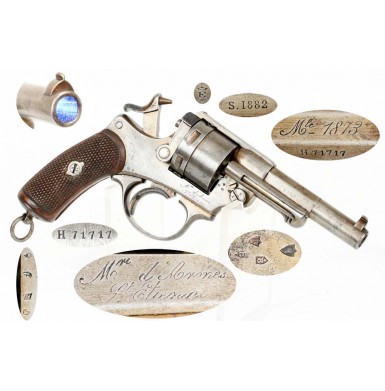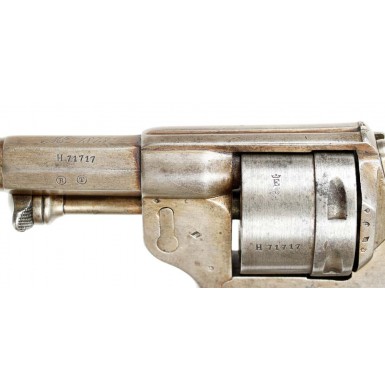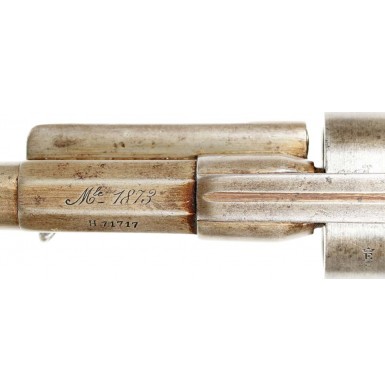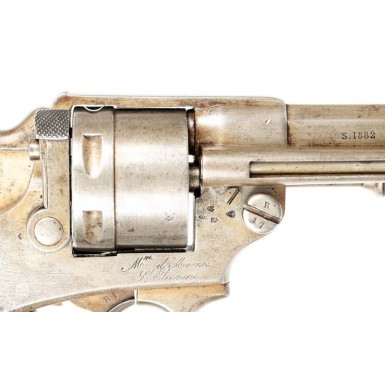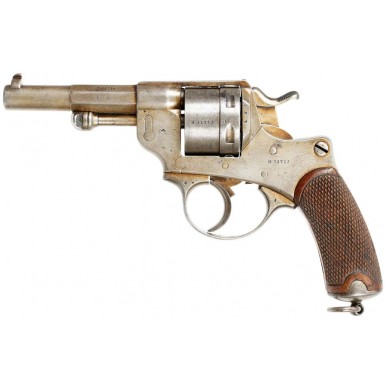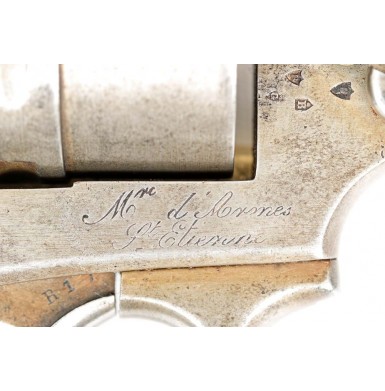Chamelot-Delvigne M-1873 French Ordnance Revolver
- Product Code: FHG-1817-SOLD
- Availability: Out Of Stock
-
$1.00
In 1858 the French Navy became the first military organization to adopt a self-contained metallic cartridge handgun for general issue and use. The gun was the Lefaucheux M-1858 Revolver, based upon Lefaucheux’s earlier M-1854. The single action revolver was chambered for the 11mm pinfire cartridge, a self-contained metallic cartridge that was more reliable and robust than any of the paper or skin percussion cartridges of the era. With this major advancement in technology and by taking the lead by embracing a new technology, it would be reasonable to assume that the French military would adopt cartridge revolvers for all of their armed services, but they did not. In fact, at the conclusion of the Franco-Prussian War in May of 1871, the standard French military handgun remained the M-1822 T bis, a single shot, muzzleloading pistol altered to percussion from its original flintlock configuration! While this may seem incongruent as the French army had adopted the M-1866 Chassepot needle-fire, bolt-action rifle five years earlier, their handguns were from an earlier and obsolete era. The French defeat in the Franco-Prussian War resulted in the loss of the Alsace-Lorraine regions of France to Germany, the capture and abdication of the French Emperor Napoleon III and in having to pay a large war indemnity to Germany. These humiliations were crushing to the French people and the military immediately started a process of modernization to bring its small arms technology up to the European standard of the era, and if possible beyond it; all in an attempt to avoid any future massive military defeats. As history would show, only two generations later, German military forces would again massively humiliate the French.
In 1871 a French military committee began to investigate potential handgun designs for adoption and general issue. The committee felt that a self-contained metallic cartridge revolver was the only logical choice and with a strong dose of nationalism directing their search, the committee selected four potential candidates. These guns were the French Lefaucheux M-1870 Pin Fire revolver currently in use by the French Navy (the successor to the earlier M-1858), the M-1872 Galand, a revolver made by Pirlot Frères of Belgium (co-designed by retired French Army officer Henri-Gustave Delvigne), and a revolver design being promoted by the French arsenal at Puteaux. It appears that some of the decision-making was based not upon the qualities of the guns being evaluated, but by politics and possibly personal gain. The Lefaucheux design appears to have been dismissed out of hand because of the rivalry between the French army and navy, and because Eugene Lefaucheux was an intimate with the now deposed French Emperor Napoleon III. By the same token, there was considerable pressure to look upon the Pirlot Frères submission favorably. This revolver was known as the Chamelot-Delvigne design, and had been pioneered by French army officer and arms designer Henri-Gustave Delvigne. Delvigne had also invented the Delvigne breech for muzzleloading rifles and had been instrumental in influencing Claude Mini” in the design of the classic expanding base Mini” Ball projectile. Delvigne had worked together with Belgian designer J. Chamelot to perfect the revolver, which was finally put into production by Pirlot Frères in 1871. The Swiss adopted the design almost immediately, the Dutch two years later, and the Italians soon after. The combination of the revolver’s French heritage and current military use by other European powers should have been sufficient reasons for the board to look upon the revolver favorably. There was, however, one additional factor that probably swayed the board even more than the previous success of the Chamelot-Delvigne design; Henri-Gustave Delvigne was on the very board to investigate and adopt a revolver design for the French! It appears that the “fix was in” when it came to the trials of these handguns and in 1873 the board recommended the adoption of the Chamelot-Delvigne revolver.
The Chamelot-Delvigne M-1873 Ordnance Revolver was what modern firearms enthusiast would call a “conventional double action design”, in that the revolver could be used as either a double-action or single-action revolver. The revolver was 9 ““ in overall length with a 4 ““ octagon-to-round barrel, rifled with 4-grooves with a right-hand twist. The gun had a solid frame and a six-shot cylinder that was loaded through a gate on the right side of the frame. The gate defined current convention by opening to the rear, rather than pivoting to the right of the frame as most loading gates of the era did. In reality, this was a more natural way to operate the gate, allowing the user to do so with the thumb of his right hand, without changing his grip on the revolver. A robust ejector rod was mounted in a housing on the right side of the barrel, and the kidney shaped plunger knob was retained by spring tension until the user released it. The revolver was chambered for the 11mm Chamelot-Delvigne cartridge (11mm x 17.8mmR), which was a center-fire black powder round that fired a 180-grain projectile at about 804 ft/s, generating about 253 ft/lbs. of muzzle energy. As Garry James points out in his well written article on the M-1873 Ordnance Revolver (see the American Rifleman website), this cartridge was slightly less powerful than the Smith & Wesson .44 Russian cartridge, which was in general use by the Russian and Japanese forces of the era, as well as around the world in Smith & Wesson top-break revolvers. The sights of the revolver were rudimentary, as was common of the period. They consisted of a large, robust front sight blade on a large base near the muzzle and a sighting groove cut into the top strap of the frame to serve as a rear sight. One of the innovations of the revolver was its removable side plate, located on the left side of the frame. Be removing a single screw, the entire lock work of the revolver was exposed for cleaning or repair, a huge improvement over most of the competing designs of the era that required complicated disassembly to access most of the internal parts of the handgun. In addition to the standard M-1873, a “Marine” (Navy) variant of the M-1873 was produced as well as the M-1873X. The “X” model was a revolver for training purposes only, and was assembled from rejected parts that had failed to pass inspection. An officer’s variant, designated the M-1874 was produced for both the army and navy, and was essentially identical to the standard M-1873 with the exception of being slightly smaller and lighter, with a blued finish and fluted cylinder. The family of M-1873 revolvers was manufactured at the French National Armory at St. Etienne, with some 386,759 revolvers being produced there between 1873 and 1885; this number includes some 13,188 M-1873 “Marine” revolvers, 35,174 M-1874 Officer’s revolvers and 1,316 “Marine” Officer’s Revolvers. The guns were left “in the white” (with the exception of the M-1874 Officer’s variant which was blued) with no finish and polished bright, although the triggers and hammers took on a “straw” colored appearance due to the heat-treating. The grips were checkered walnut of the two-piece variety and a lanyard ring was included in the buttcap. In typical French Ordnance tradition, the guns were profusely marked with inspection and proof marks and were serial numbered on every part large enough to accept the number, and with the last two-digits on those parts too small for the number. These two-digit numbers were usually accompanied by a letter, which represented an inspector. The model designation was engraved on the top barrel flat and the date of manufacture stamped on the right flat, preceded by an “S’ to indicate St. Etienne. Serial numbers ran in batches of 100,000, with a letter pre-fix that changed every 100,000 guns. The letter prefixes for the M-1873 revolver began with F and ended with J, the letter “I” was not used due to the possibility that it would be confused with “J”, thus only the letters F, G, H & J were used. St. Etienne arsenal records indicate that the first revolver was F1, produced in 1873 and the last was J34695 produced in 1885. Although the M-1873 revolver was officially replaced by the short lived M-1887 in that year, and subsequently by the M-1892, the M-1873 remained in service through World War I as a secondary revolver and some even saw service through World War II as last-ditch arm. Some sources report that M-1873 Ordnance Revolvers were still in use as late as the early Vietnam War era by French forces in French Indo-China, and if that is the case, there is no doubt that the guns saw use by Viet Minh, Viet Cong and possibly North Vietnamese forces as well. This means that the revolver that only had a 14-year official service life actually served the French military for nearly 90 years!
Offered here is a VERY FINE condition example of the French M-1873 Chamelot-Delvigne Ordnance Revolver. The gun is 100% complete, correct and original in every way. The gun was produced in 1882 at the St. Etienne Arsenal, and has all matching serial numbers throughout: H71717. The gun is very well marked throughout and remains very crisp and sharp. The top barrel flat is marked in script Mle 1873, and the lower right side of the frame (below the cylinder) is marked in script in two lines: Mre d’Armes / St. Etienne. The left side plate of the frame is stamped with the serial number H71717, and this full serial number appears on the triggerguard, cylinder, ejector rod housing, barrel, trigger, hand, hammer, sear and mainspring tension block. The smaller parts, like the screw heads, all bear the inspector initial R over the last two digits of the serial number 17. Both grip panels are also stamped 17 on their interiors. The cylinder is marked with the expected (CROWN) / E military acceptance mark, which is over a small raided D in an oval inspection mark. A plethora of controller, inspector’s and viewer’s marks are found on the gun, including a raised B within an rhomboid, a raised B within a shield, a raised (CROWN / P in an oval, a raised G in a shield and a (CROWN) B in a pentagon, among others. The right side of the octagon barrel portion is stamped S. 1882 for St. Etienne 1882, the year of the production at that arsenal. As noted the gun remains crisp throughout and all marking remain relatively clear and legible. The metal of the revolver is mostly smooth with a medium dull pewter patina and light coating of old dried oil that has given the revolver a slightly yellowish-brown tone. This old oil could be cleaned off if so desired. The revolver does show some lightly scattered minor surface oxidation, flecks of brownish discoloration and couple of small areas of minor pinpricking. These are scattered in tiny patches on the frame, cylinder and barrel and are all the result of carry, firing and real world use and wear. The hammer and trigger both retain strong traces of their original strewed coloring, which is actually enhanced by the color of the dried oil on these parts. The mechanism is mechanically EXCELLENT and the revolver times, indexes and locks up perfectly, exactly as it should. The loading gate functions smoothly, and the ejector rod remains tightly secured until the plunger tip is pulled forward and rotated to the right for use. The ejector rod functions smoothly and correctly as well. The original lanyard ring is in place in the butt cap of the revolver and still moves freely, as it should. The bore of the revolver is in VERY FINE condition and remains quite bright and retains very crisp, four groove rifling. The bore shows only some very lightly scattered pinpricking and minor pitting and would probably improve with a good cleaning. The two-piece checkered walnut grips are in FINE condition as well. They are solid and free of any breaks, cracks or repairs. The grips show some light handling wear and minor bumps and dings, and only the most minor flattening to the sharp edges of the checkering. Overall the grips remain in very nice condition, commensurate with the balance of the revolver.
Overall this is a very nice, well marked, all matching and extremely crisp example of a French Chamelot-Delvigne M-1873 Ordnance Revolver. These historic revolvers were the first cartridge revolvers adopted by the French Army and remained in service, although on a limited basis, through both World Wars and saw service all the way to Dien Bien Phu in 1954. These are important revolvers that ushered in a new age of modern handguns to military service. From a design standpoint the French 1873 Ordnance Revolver was a much more advanced design than the US M-1873 Single Action Army, and the fact that the M-1873’s basic design of a solid framed double action revolver remains in use today for most modern revolvers is a testimony to how far-sighted Delvigne and Chamelot really were. This is a very nice example that is reasonably priced and will be a great addition to your collection of 19th century military revolvers.
SOLDTags: Chamelot, Delvigne, M, 1873, French, Ordnance, Revolver


